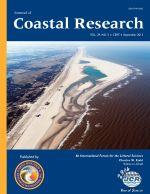Shearman, P.; Bryan, J., and Walsh, J.P., 2013. Trends in deltaic change over three decades in the Asia-Pacific region
Over the past decades, studies have shown considerable change in mangrove and deltaic systems around the world. Arguments for the controlling processes encompass natural and anthropogenic phenomena, including sea level rise, storms, sediment supply changes and enhanced subsidence. To evaluate whether similar gross trends are apparent across several larger systems, this research employed a consistent methodology to conduct region-wide change analyses of five major mangrove deltaic systems in the Asia-Pacific region that are reported to be under varying degrees of risk (“no risk,” Fly and Kikori-Purari; “in peril,” Ganges-Brahmaputra, Irrawaddy, Mekong). With the use of a full-scale semiautomated classification, the extent of mangroves was mapped and compared for two Landsat satellite image series at least 20 years apart. Overall, we found a net contraction in mangrove area of 76 km2, or −0.28%, but trends in mangrove change varied across the five systems. We document net contractions in the Ganges-Brahmaputra, Fly, and Kikori-Purari and a net expansion in the Irrawaddy and Mekong. The biggest relative decline in mangrove area occurred in the Fly delta, which experienced a decline of 3.9% over 36 years. The largest relative increase of 2.7% over 20 years occurred in the Irrawaddy, whereas the Mekong was relatively stable with only a modest 0.14% decline over 20 years. System-wide patterns and rates of change were variable and complex. Generally, erosion is occurring at the mouths of rivers, where exposure to ocean processes (e.g. waves) is greatest, despite the large sediment supply by these great rivers (albeit reduced in some cases). The observed losses in the Ganges-Brahmaputra are not surprising considering the known anthropogenic effects, but given that similar change trends are occurring in the Fly and Kikori-Purari delta systems despite potentially increased sediment loading (e.g. from deforestation and mining) and without other anthropogenic effects (subsurface withdrawals or river rerouting), some of this morphological change might be attributed to an enhanced eustatic sea level rise. However, change in climate, marine processes (e.g. wave conditions), effective sea level rise (e.g. a local oceanographic or tectonically controlled response), or autogenic geomorphodynamics cannot be ruled out. Alarmingly, deltas that have the greatest and most intact mangrove systems (the Fly and Kikori-Purari systems) or those parts of deltas that are still forested, such as in the western Sundarbans, are being eroded the fastest of the studied systems. A more concerted effort to monitor large-scale delta changes is recommended.





